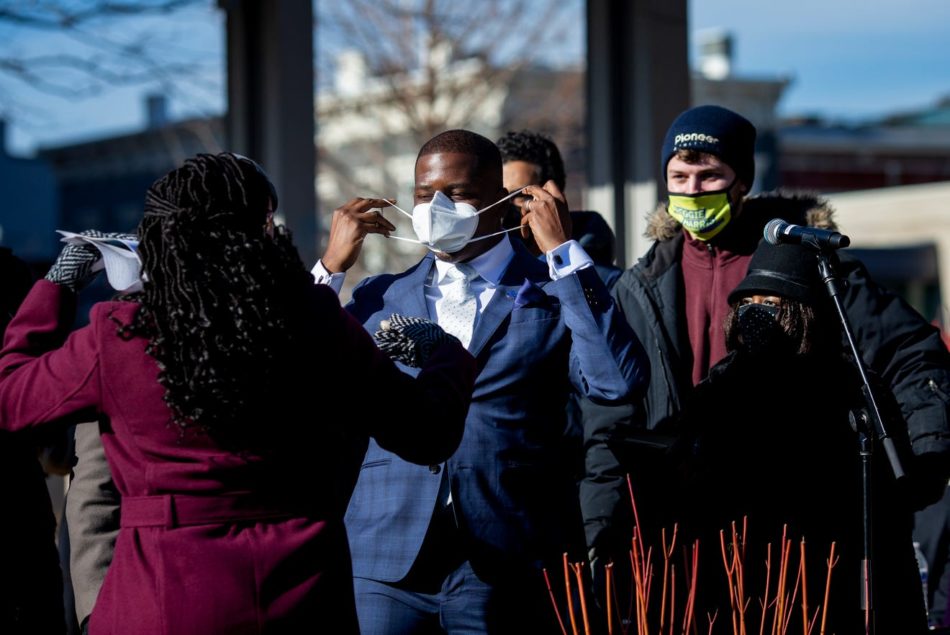Talk among health experts and a possible change in federal masking guidelines that have arisen with the exponential spread of COVID-19 may have you wondering whether you’ll be wearing N95 masks soon and if so, what that will mean.
Should you get an N95 of KN95 mask to protect yourself from COVID-19 now? Should you ditch your cloth masks? Your surgical masks? How are these filtering facemask respirators better or worse in protecting you or your child from the pandemic virus?
The rapid spread of COVID-19 triggered by the omicron variant on Thursday prompted President Joe Biden to promise availability, free, of “high-quality masks” including N95s to Americans soon. On Friday, the Centers for Disease Control and Prevention encouraged more Americans to wear N95 or KN95 masks.
Omicron:Why cloth masks aren’t the best at blocking it
N95 vs KN95: What to know
Mask mandate renewed: Cincinnati again requiring them in city facilities
Area doctors who are dealing with the onslaught of COVID-19 cases and infectious disease experts have varying opinions on the need for and protection level of N95s and KN95s, but they all say masks – accompanied by safe distancing – must fit and be worn properly to provide the best protection.
Most people are still wearing cloth masks. Here’s why that’s a problem with omicron
Masks do three things, said Dr. Robert Frenck, an infectious disease specialist and director of the Gamble Center for Vaccine Research at Cincinnati Children’s Hospital Medical Center.
- They trap particulate matter when you cough or sneeze.
- If someone coughs in your direction while you’re wearing a mask, the mask will stop a lot of that particulate matter from reaching you.
- They provide a “visual cue” to keep a distance from others.
“The short answer is: I think all of the types of masking will help,” he said. “But masking only works when you have your mask on. And that’s why the vaccines are our better way to go – because that protects us all the time.”
Compared to a cloth mask, which may only have one layer, N95 and KN95 masks have three layers of fabric: an outer layer of non-absorbent fabric such as polyester, a middle layer of a non-absorbent material such as polypropylene, and an inner layer of an absorbent material such as cotton.
“The most effective mask against any respiratory pathogen is the highly protective N95 or KN95,” said Dr. Helen Koselka, chief medical officer for TriHealth. “In order for the mask to function in the way it is designed, it has to be fit-tested, meaning checked for the right fit for the face, and different brands fit differently, just like shoes.”
The Occupational Safety and Health Administration requires respirator users to be fit tested to confirm the fit of any respirator that forms a tight seal on a healthcare worker’s face before using it, according to the CDC. That’s not going to happen for just anyone buying the mask, of course. But it shouldn’t prevent someone from wearing an N95 or a KN95.
“The general public can wear one, and … any mask is better than no mask,” Koselka said.
Dr. Thomas Lamarre, an infectious disease specialist at the Christ Hospital Health Network, cautioned about the N95 as well.
While they’re the “most efficient in filtering droplets and aerosols that contain infectious virus and offer the highest protection among available masks,” he said they need to be fit tested by a healthcare professional to achieve that level of protection. Lamarre also said the N95s don’t work well with facial hair, and they’re uncomfortable to wear for long periods of time.
“I recommend medical-grade surgical masks should be the type of mask to wear routinely,” Lamarre said.
Shanina Knighton, a clinical nurse scientist at the Frances Payne Bolton School of Nursing at Case Western Reserve University who is certified in infection prevention and control, is among Ohio experts who do not recommend the N95 or similar masks for the general public.
Knighton suggests wearing a three-layer mask with a pocket for incorporating a filter, adjustable ear loops to and a nose-bridge wire to keep it fitted to your face.
She also said it’s vital to wash hands before putting on the mask and before removing it and to take it off ear to ear – not push it down below your chin, which may have been exposed to COVID-19 particulate.
Other doctors reached by The Enquirer agreed that fit testing – which ensures the N95 is doing what it’s supposed to do, filtering at least 95% of particles in the air – is important. But they still think the N95 and similar KN95 are better than the cloth masks most people have been wearing.
“Commercial N95 masks that are not fit-tested are still more effective than surgical masks,” said Dr. Imran Naqvi, vice president of medical affairs at the Jewish Hospital – Mercy Health. “And I would strongly encourage the public to use an N95 plus eye protection if you’re at home taking care of a sick family member when possible.”
Dr. Barry Wendt, an internist for St. Elizabeth Healthcare, said he doesn’t think that everyone needs to wear such a mask, but he advises that those caring for people with COVID-19, even at home, wear them.
Can an N95 or KN95 be reused?
The medical professionals said wearers should change them after a couple of uses and use another if at all possible. And Knighton said reuse isn’t the best practice.
“In healthcare, these masks were never meant for reuse, and in today’s environment they undergo special processing to clean,” Knighton said.
People who aren’t in healthcare can reuse the masks up to five times, under CDC guidelines. Some experts say to rotate the masks and be sure to wash your hands thoroughly before touching them.
Dr. Joseph Gastaldo, a physician who specializes in infectious diseases with OhioHealth in Columbus, told USA TODAY he recommends each person purchase a pack of N95’s and rotate when they wear each mask.
“If you’re rotating your masks, washing your hands and storing them well, you can get five to a little bit more uses with them,” he said. Once a mask is frayed, has stretched out straps or shows other signs of deterioration, toss it.
Other CDC recommendations:
- Don’t use soap and water for cleaning. Instead, heat the mask to a maximum of 158 degrees for one hour, hanging the mask in your oven using a wooden or plastic clip.
- Remember to check the fit afterward, because decontamination can change the way a mask fits, and proper fit of the masks is important.
- Look for National Institute for Occupational Safety and Health-approved masks
N95 masks are your best mask option—here’s where to buy them online
Do N95 and KN95 make it hard to breathe?
No. The masks allow carbon dioxide to escape. The CO2 molecules are small enough to easily pass through mask material, according to the CDC. In contrast, the respiratory droplets that carry the virus that causes COVID-19 are much larger, so they cannot pass as easily through a properly designed and properly worn mask.


